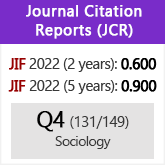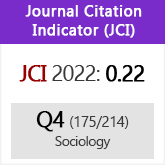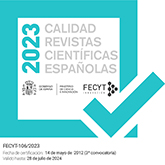The Moral Gaze on TV Violence. Analysing audience discourses
DOI:
https://doi.org/10.3989/ris.2009.09.07Keywords:
Audience, Discourse Analysis, Media Violence, TelevisionAbstract
Our research tries to include the audience views on media violence, emphasizing the active role of audience vis-à-vis media messages, much like Audience Reception Research has done. Through the discourse analy sis of eight focus groups on TV violence, our results show the structuring quality of the reality/fiction dimension for viewers’ understanding of violence. Also highlighted is the important moral component of these discourses, that is, the moral gaze that characterizes an audience’s orientation toward media violence, making some orientations to watch TV violence acceptable, while others are considered unacceptable and, in connection with the previous dimension, is developed around victim, real violence, or around hero, fictional violence.
Downloads
References
Alonso, L. E. 1998. La mirada cualitativa en sociología. Madrid: Fundamentos.
Aran, S., F. Barata, J. Busquet, P. Medina y S. Moron. 2003. “Infancia, violencia y televisión: usos televisivos y percepción infantil de la violencia en la televisión.” Quaderns del CAC 17: 23-31.
Boltanski, L. 1999. Distant Suffering. Morality, Media and Politics. Cambridge: Cambridge University Press. http://dx.doi.org/10.1017/CBO9780511489402
Buckingham, D. 1996. Moving Images: Understanding Children’s Emotional Responses to Television. Manchester: Manchester University Press.
Bushman, B. J., L. R. Huesmann y J. L. Whitaker. 2009. “Violent media effects”. Pp. 361-376, en Media processes and effects, edited by R. L. Nabi and M. B. Oliver. Thousand Oaks: Sage.
Callejo, J. 1995. La audiencia activa. El discurso televisivo: discursos y estrategias. Madrid: Centro de Investigaciones Sociológicas.
Chouliaraki, L. 2004. “Watching 11 September: the politics of pity.” Discourse & Society 15:185-198. http://dx.doi.org/10.1177/0957926504041016 PMid:9188076
Corner, J. 2000. “What Do We Know about Documentary?.” Media, Culture and Society 22:681-688. http://dx.doi.org/10.1177/016344300022005009
Davison, W. P. 1983. “The third-person effect in communication.” Public Opinion Quarterly 47:1-15. http://dx.doi.org/10.1086/268763
Del Río, P., A. Álvarez y M. del Río. 2004. Pigmalión. Informe sobre el impacto de la televisión en la infancia. Madrid: Fundación Infancia y Aprendizaje. (Accesible en http://ares.cnice.mec.es/informes/03/documentos/indice.htm).
Denzin, N. K. 1991. Images of Postmodern Society: Social Theory and Contemporary Cinema. Londres: Sage.
Gauntlett, D. 1998. “Ten things wrong with the ‘effects’ model”. Pp. 120-130 en Approaches to audiences: a Reader, edited by R. Dickinson, R. Harindranath y O. Linné. Londres: Arnold.
Gauntlett, D. 2001. “The worrying influence of ‘media effects’ studies”. Pp. 47-62 en Ill effects: the media/violence debate, edited by Martin Barker y Julian Petley. Londres: Routledge.
Gauntlett, D. y A. Hill. 1999. TV Living: Television Culture and Everyday Life. Londres: Routledge.
Gerbner, G. y L. Gross. 1976. “Living with television: The violence profile.” Journal of Communication 26:172-199. http://dx.doi.org/10.1111/j.1460-2466.1976.tb01397.x
Hall, S. 1980. “Cultural studies: Two paradigms.” Media, Culture & Society 2: 57-72. http://dx.doi.org/10.1177/016344378000200106
Hargrave, A. M. 1993. Violence in Factual Television. Londres: John Libbey.
Harré, R. 1984. Personal Being. Oxford: Basil Blackwell.
Hill, A. 1997. Shocking Entertainment: Viewer Response to Violent Movies. Luton: University of Luton Press.
Hill, A. 2000. “Fearful and Safe. Audience Response to British Reality Programming.” Television & New Media 1:193-213. http://dx.doi.org/10.1177/152747640000100205
Hill, A. 2001. “«Looks like it hurts». Women’s responses to shocking entertainment”. Pp. 135-149 en Ill effects: The media violence debate, edited by Martin Barker y Julian Petley. Londres: Routledge.
Hill, A. 2002. “Big Brother. The Real Audience.” Television & New Media 3:323-340. http://dx.doi.org/10.1177/152747640200300307
Höijer, B. 1992. “Socio-cognitive Structures and Television Reception.” Media, Culture and Society 14: 583-603. http://dx.doi.org/10.1177/016344392014004006
Ibáñez, J., ed. 1979. Más allá de la Sociología. El grupo de discusión: técnica y crítica. Madrid: Siglo XXI.
Ignatieff, M. 1997. The Warrior’s Honor. Ethnic War and Modern Conscience. Nueva York: Henry Holt.
Imbert, G. 2007. “Violences symboliques et jeux avec les limites dans la post-te´le´vision.” Les politiques sociales 21:35-50.
Jensen, J. y J. J. Pauly. 1997. “Imagining the audience: Losses and gains in Cultural Studies”. Pp. 155-169 en Cultural Studies in Question, edited by Marjorie Ferguson y Peter Golding. London: Sage.
Lindlof, T. R. 1991. “The qualitative study of media audiences.” Journal of Broadcasting & Electronic Media 35: 23-42.
Lull, J. 1988. World Families Watch Television. Newbury Park: Sage.
Lunt, P. K. y Livingstone, S. M. 1992. Mass Consumption and Personal Identity: Everyday Economic Experience. Buckingham: Open University Press.
Martínez Nicolás, M., F. Bermejo, J. M.ª García de Madariaga, M. A. Moreno, P. Planas y F. Tucho. 2008. “La boda real espanola como acontecimiento media tico. Audiencias y estrategias de recepción en la retransmisio’n televisiva de la boda del Pri’ncipe de Asturias.” Revista Internacional de Sociología 50: 65-93.
Morley, D. 1980. The ‘Nationwide’ Audience. Structure and Decoding. Londres: British Film Institute.
Nightingale, V. 1996. Studying Audiences: The Shock of the Real. Londres: Routledge.
Nightingale, V., D. Dickenson y C. Griff. 2001. “Children’s views on media harm.” Metro Magazine 131/132:212-224.
Ortí, A. 1986. “La apertura y el enfoque cualitativo o estructural: la entrevista abierta y la discusión de grupo”. Pp. 153-185 en El análisis de la realidad social. Métodos y técnicas de investigación, compilado por M. García Ferrando, J. Ibáñez y F. Alvira. Madrid: Alianza.
Parker, I. 1992. Discourse Dynamics. Londres: Routledge.
Potter, J. y M. Wetherell. 1987. Discourse and Social Psychology: Beyond Attitudes and Behaviour. Londres: Sage.
Potter, W. J. 2003. The 11 Myths of Media Violence. Thousand Oaks: Sage.
Potter, W. J. y T. K. Tomasello. 2003. “Building Upon the Experimental Design in Media Violence Research: The Importance of including receiver interpretations.” Journal of Communication 53: 31529. http://dx.doi.org/10.1111/j.1460-2466.2003.tb02593.x
Ramírez, J. M. 2007. “Televisión y violencia.” Revista Latinoamericana de Psicología 39: 327-349.
Ramírez, J. M., J. M. Andreu, T. Fujihara, Z. Musazadeh y S. Saini. 2007. “Justification of aggression in several Asian and European countries with different religious and cultural background.” International Journal of Behavioral Development 31(1): 9-15.
Shaw, R. L. 2004. “Making sense of violence: a study of narrative meaning.” Qualitative Research in Psychology 1:131-151. http://dx.doi.org/10.1191/1478088704qp009oa
Tulloch, J. y M. I. Tulloch. 1993. “Understanding TV violence: a multifaceted cultural analysis”. Pp. 211-245 en Nation, culture, text: Australian cultural and media studies, edited by G. Turner. Londres: Routledge.
Vorderer, P., C. Klimmt y U. Ritterfeld. 2004. “Enjoyment: At the Heart of Media Entertainment.” Communication Theory 14:388-408. http://dx.doi.org/10.1111/j.1468-2885.2004.tb00321.x
Wilson, B. J., D. Kunkel, D. Linz, J. Potter, E. Donnerstein, S. Smith, E. Blumenthal y T. Gray. 1997. “Violence in television programming overall: University of California, Santa Barbara Study”. Pp. 3-267 en National television violence study, vol. 1, Thousand Oaks: Sage.
Downloads
Published
How to Cite
Issue
Section
License
Copyright (c) 2011 Consejo Superior de Investigaciones Científicas (CSIC)

This work is licensed under a Creative Commons Attribution 4.0 International License.
© CSIC. Manuscripts published in both the printed and online versions of this Journal are the property of Consejo Superior de Investigaciones Científicas, and quoting this source is a requirement for any partial or full reproduction.All contents of this electronic edition, except where otherwise noted, are distributed under a “Creative Commons Attribution 4.0 International” (CC BY 4.0) License. You may read here the basic information and the legal text of the license. The indication of the CC BY 4.0 License must be expressly stated in this way when necessary.
Self-archiving in repositories, personal webpages or similar, of any version other than the published by the Editor, is not allowed.

















